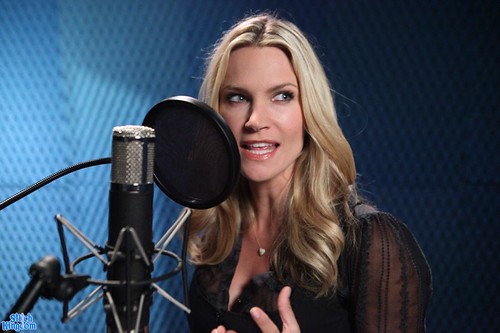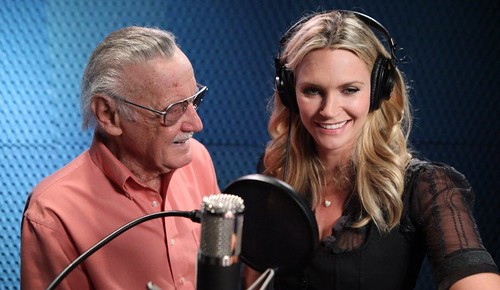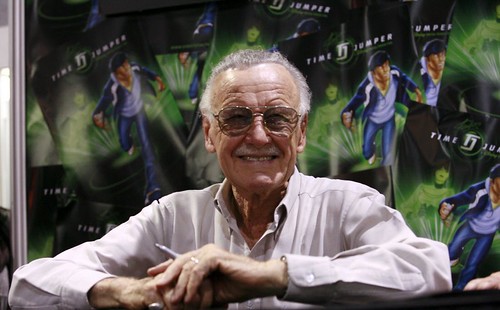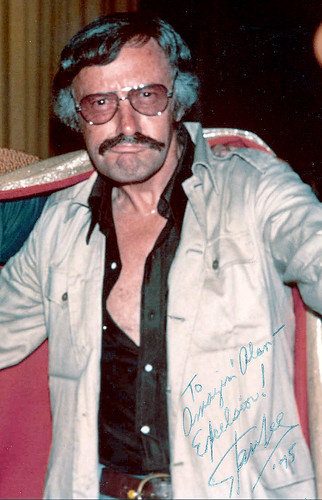William Bibbiani talks Time Jumper with Stan Lee & Natasha Henstridge!
From Stan Lee and POW! Entertainment comes Time Jumper, a new animated comic book exclusively available on iTunes this summer. Lee created this tale of Terry Dixon, the owner of a time travel device specifically tuned to his family DNA. With his hotshot superspy brother mysteriously missing, it falls to Terry to use the device for H.U.N.T. (Heroes United, Noble and True) to save the world. He just doesn’t want to. We spoke to Natasha Henstridge, starring as the villainous Charity Vyle, and creator Stan Lee, who also guest stars as Lee Excelsior, CEO of H.U.N.T.!
First came Natasha Henstridge, best known for her roles in Species and The Whole Nine Yards.

What is the funniest moment that you can remember from your interaction with Stan Lee?
Natasha Henstridge: (Pause) – I just think he’s so adorable, and such a flirt too. He’s so sweet, so lovely. We’re doing pictures, he’s like, “Is that it? I could stay here all day! Are you sure you got it?” He’s (got a) fabulous, animated voice. He’s a lovely guy, to be the legend that he is but genuinely have that childlike love of what he does, still, and also to be able to be with the people still and not alienate people. He’s really amazing in that way.
What was it about it about Violet that grabbed you?

Natasha Henstridge: Um… She’s brilliant? I love playing those characters… finally I get to have one of those Dr. Evil finger at the corner of the mouth moments in your career where you really get to go for it. So it’s not an undercurrent, like she’s a little bit nasty, but full-on, “This Woman Wants to Take Over the World and Change History and Future As We Know It.” It’s just fun to play a character like that.
William Bibbiani: Is this medium freeing for you at all? You’re doing such short episodes, where you’re given so little time in each individual one with the character. Does that allow you to play it a bit more openly than perhaps you would normally?
Natasha Henstridge: You know what? I love that. I love that we actually went in and did five episodes back-to-back so you know exactly where you came from and exactly where you’re going. And there’s five episodes, so it’s not like you’re coming back after weeks and days of sitting in your trailer for hours on end in between, and “Oh God, where was I then?” In that way, you really stay super-connected in the moment to exactly what’s happening to you.
William Bibbiani: You did it all in one day?
Natasha Henstridge: (Nods) – We did five episodes in one day.
Are you contracted to do a certain number of episodes?
Natasha Henstridge: I think, like anything, it will all depend on the reception. But we’re doing ten so far.
How many are you willing to do? What if this goes on forever?
Natasha Henstridge: I would love that. Because you know what the beauty of it is? They can keep me looking young forever. (Laughs.)
When asked about the difficulty in retaining vocal qualities over extended periods:
Natasha Henstridge: Well you do kind of have to remember… Like when I go back, having done the first five, it will be interesting to go back and do the next five. I will have seen them at that point, so that’ll help a little bit. Because you can lose it a little bit, too. As we were going through the first five, we’d take a little break and then come back. You do forget where you were tone-wise or something. “Oh, I’m a little bit girlier now,” or something, you know? And they bring you back, you work with people, in this case the director… who keeps you very aware of what you’re doing, because he does that kind of thing all the time. So he can really hear it and listen for that.

Have you had any vocal acting training?
Natasha Henstridge: I’ve never had any training. Of any kind. Even at the gym. (Laughs.) …I’ve always liked voice-work. I did a little bit on South Park, and then I got an agent to start doing voice stuff because I have a lot of wacky voices I like to do, a lot of funny, cartoony-type things. I have my own little characters that I’ve made up and stuff, as well. I’m just waiting for the chance.
Someone jumps on it: Can we hear them now?
Natasha Henstridge: (Suddenly Helium-ish) – Some of them are just weird and funny, and one is called Chamomile. She makes people happy. (Normal) – There’s just lots of funny things… A lot of weird stuff… I like Chamomile because there’s nothing relaxing about that voice at all.
Some Guy: What do you know about Fanboys?
Natasha Henstridge: Um, I don’t… You mean the actual…
William: He means us.
Natasha Henstridge: He means you guys?
William: Yeah.
Natasha Henstridge: Fanboys is a magazine, or is…?
Some Guy: There’s a movie.
William: There’s a movie called Fanboys, and a lot of publications that have utilized the term, but “fanboys” are just people who are…
Natasha Henstridge: Fanboys. Boys who are fans. And girls.
William: Well, people who are passionate about genre material, or a certain medium.
Natasha Henstridge: I think anyone who is dedicated to something, no matter what it is, if they have a passion for something and a dedication for something, I think it’s very cool… Comics, music, I mean we all have our thing.

Next came Stan Lee, all-powerful God of Geekdom. The “Man,” if you will. Upon his arrival, a publicist presents a stack of Time Jumper posters signed earlier by Stan.
Stan Lee: She forces you to take them whether you like ‘em or not.
Publicist: No, no!
Stan Lee: They’re sitting here right now, “Another thing I gotta carry home…”
Publicist: All your hard work of signing them went to good use!
Stan Lee: Well, I hope it’s appreciated. (Laughs)
Why bring Time Jumper to Disney, as opposed to an imprint of Marvel?
Stan Lee: Well, I have this little company, POW Entertainment, which of course stands for “Purveyors of Wonder” – but I’m sure you’ve figured that out – and POW Entertainment has an arrangement with Disney. We have what they call a “First Look” deal. Anything that I come up with I have to offer to the Disney company first. If they want to do it, great! If they don’t want to do it, then we’re free to sell it anywhere else. So when I had the idea for Time Jumper I of course offered it to Disney, they liked the idea, and the rest is history.
Was Stan going to be a character in the series from the beginning? Was that “part of the deal?”
Stan Lee: The fact that I’m in it? That I’m “The Star?” No, that was their idea. I never insist on that with anything! I love doing it, but they came up with the idea, which I got a big kick out of.

William Bibbiani: I saw you at the panel and you were really excited about new “animated comic” medium that you’re going for here. (But) you also said that the story came first. Did you come up with the story and then come up with the idea to do it as an animated comic book, or did you really want to do an animated comic book and are now looking to find some story to work with in that medium?
Stan Lee: No, the story really came first. And then, as I was talking to the people at POW, they had heard about this type of “near” animation, and they thought it would be a good idea. I just found out about this – I didn’t realize, somebody just told me – I thought that we just gave Disney the story and they came up with this process, but apparently WE suggested this process to Disney… But they of course embellished on it… and I think they did a wonderful job.
William Bibbiani: Well, it’s really funny, because I was actually introduced to your work through the cartoons from the 1960’s – Thor and Iron Man – and they were also very limited animation, and they all just seemed like Jack Kirby’s panels in close-up with some voice-overs. This is very in keeping with your works. I was wondering if that had anything to do with it, or if no one even thought about that?
Stan Lee: Those old cartoons were funny. Sometimes it was just a drawing from the book and they’d move the lips.
William Bibbiani: Sometimes they didn’t even bother moving the lips! “Why bother? It’s fine.”
Stan Lee: (Laughs) – Moving the lips? Those were the expensive versions.
William Bibbiani: Your words were so magical…
Stan Lee: Oh, I like this guy.
William Bibbiani: That they supersede lip synching.
Stan Lee: I hope nobody says anything after that to spoil that. (Gets up) – And on that happy note, it was nice seeing you. (Laughs.)
In 2013 (just off the top of someone’s head), when Superman’s creators own the copyright to the character and he is no longer wholly owned by DC, would Stan be interested snatching him up for the Marvel Universe?
Stan Lee: Have Superman be part of the Marvel Universe…? I had never thought of it. See, I’m with Marvel, but I’m not really part of the Marvel decision-making team. I think my title is “Chairman Emeritus,” which really doesn’t mean much, because I spend most of my time with POW. The only thing (is) Marvel, to prove they haven’t forgotten me… I have these cameos in the movies which is kind of nice. And people still come to the movies. That’s nice.
Some Guy: You’re still the magic, so…
Stan Lee: Don’t you forget it. (Laughs.)
The Same Guy asks what Stan’s story would be for Superman.
Stan Lee: I did a Superman story once. I don’t know if you ever saw that series, “What if Stan Lee had created…” (EDITOR’S NOTE: It was called “Just Imagine,” if any of our readers wants to track them down in trade paperback). I did that a few years ago. I did one with Superman, Batman, Green Lantern, about ten of them. I’d go back and I’d have to read that. I think I had Superman (as) a guy from another planet, but he was, I think, a criminal, and he landed on Earth… I forget what the Hell I did. It was a great story though. I think John Buscema illustrated it.
I never can remember the stuff I write. That’s really tragic, because it’s all good.
Is it hard to come up with an original idea these days?
Stan Lee: Yes. It’s always been hard but it gets harder all the time because just about everything has been done! I’ve got a little file of ideas that I’m going to present to Disney and other companies in a while; new heroic characters. And the one thing about them, I didn’t bother to write the whole story. I just have why they’re different from the characters who around now, and that takes a lot of thinking because if you think about it… You think about super powers, we’ve already got characters who can fly, who can shoot fire from their hands or are invisible, whatever you think of it’s been done. And yet you want to keep coming up with new characters, so it gets harder and harder. Luckily, being something of a genius I’m able to handle it. (Laughs.)
How much was Disney involved in the creative process? Did they leave him alone because he’s Stan Lee?
Stan Lee: No, no. Well, I wish people did have that attitude (laughs), but no, I act as the producer, and they do the story, they do the artwork. They send it to me for my comments, and what they do is so great my comments are very minor. The one comment I had was when one of the characters is saying something, and you put the words on the screen, open his mouth! Don’t have him drawn with his mouth shut while he’s supposed to be talking. I think that happened once or twice, it didn’t mean anything. But that’s about the level of my suggestions. They really are so good at what they do. I’m in awe of them.
How about Stan’s involvement with the actors? Natasha said she loved working with Stan.
Stan Lee: Well, I’m a joy to work with.
William Bibbiani: She did call you a flirt. She’s spreading vicious, vicious lies.
Stan Lee: My wife better not read this!

Did Stan ever feel like he had to get involved in the voice-acting, giving comments, etc.?
Stan Lee: I would like to. I would like to be at all the audio recording sessions, but I’m not. I don’t have the time to go. And again, they know what they’re doing. They’re pretty good. I go to the ones where I say something so I can thrill to how beautifully I do it, but they’re professionals. Funny thing: in some of the releases I’ve seen “Stan Lee hired Natasha (Henstridge).” I didn’t hire her! They hired her! They told me about it! I (just) said, “That’s great!”
Some Guy tells Stan to just take the credit for it.
Stan Lee: I’ll probably end up taking the credit for it. I take the credit for everything.
Asking Stan about time travel, the stories get very convoluted. What guidelines or rules do they have in Time Jumper?
Stan Lee: Well, one of the guidelines is “Don’t be too damned convoluted.” No, just tell good stories. That’s the only guideline we ever have. Tell them so that people can understand them, and so that people want to see what comes next. There should always be some suspense, but that’s it. Same guidelines you have for any story.
So no complicated whiteboard at the office keeping everything straight?
Stan Lee: Well that’s really up to (pause, thinks)… Omar! The writer. I have no memory! He’s a great writer, I might add. His dialogue and the way he cuts from thing to thing, if you read the script it’s just like a motion picture script. He’s very good.
Asking about Stan Lee’s description of the medium, a “comic book of the air,” could he expand on that?
Stan Lee: “Of the air” because you’re sending it over the airwaves. It’s probably not the airwaves. That shows how much I know about technical things, but it goes out over the airwaves! You get it on your telephone, your cell phone, you get it over the internet. You’ll see it in all its glory with all its special effects and the movement and the noise and the music and the sounds, and it’s the next evolution of the comic book, I guess. Which doesn’t mean, and don’t get me wrong, it doesn’t mean it’ll replace the comic book. It’s not meant to replace the comic book anymore than television replaced movies, or books or anything. It’s just another form of comics, really, as far as I can tell.
Finally, someone asks Stan to wax philosophical about the state of comics, from his extended perspective.
Stan Lee: Well, where they are today… If you look at an old comic book, the kind I was doing in the sixties, and you look at a present day comic book, there’s such a difference right there because (in) the new comic books every panel is like some sort of a fantastic illustration. They’re colored by computer, the lettering is done by computer. You sort of want of want to cut out almost every panel and have it framed and hang it on the wall. They’re like OIL paintings in a way. Whereas the stuff we did, and the artists were magnificent, but they were doing three pages a day sometimes. Kirby would do four pages a day. Today the artists, they spend a day or day-and-a-half on one panel, coloring it and working on it. It’s slower and it’s more painstaking, and it almost looks like a different type of storytelling.
So comics have changed in the sense… oh, and also years ago you had comics writers who were like me. Just guys who wrote comics. Today, comics have become such a big business that you have people who write screenplays, who write novels, who are doing comics because they know if they write a good one there’s a chance that it will be made into a movie and it’ll make them. You know what I mean? So, the same with the artists: years ago it was really tough to get good artists to do comics. They could make more money in advertising. Today, every artist wants to do comics because they get to keep their original artwork after its published, and the ones who are really good, they can sell those original drawings for a hell of a lot of money at a comic book convention or at an auction. And that didn’t hold true years ago, so in that sense everything has changed.
But it still boils down: You need a good story, you need good drawings, it has to be well-written, and it has to grab the reader.
